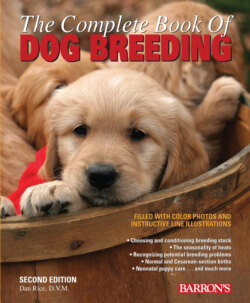Читать книгу The Complete Book of Dog Breeding - Dan Rice - Страница 33
На сайте Литреса книга снята с продажи.
Stud Dog Age
ОглавлениеWhen breeding a young bitch for the first time, it is often best to use a proven stud dog. His experience will certainly help in the actual breeding process, and a secondary benefit is your ability to see and handle his offspring from previous matings. Such studs will usually be more than a year old, perhaps much older.
Males that are proven in shows or other competitions are usually also well over a year of age. The number of champions under a year of age is relatively small. In purebred dog breeding, a stud’s age is secondary to his quality and the quality of puppies he has produced with other females.
Some novice purebred dog breeders are guilty of a serious mistake—they obtain male and female puppies of their chosen breed at the same time. Sometimes the pups are closely related, often littermates. Before they have the opportunity to establish their quality in the show ring, the female comes into heat. They aren’t old enough for conformation shows, obedience, or field trials, but they are old enough to breed. The bitch shows signs of proestrus bleeding, and the owner leaves them together, either unwittingly or intentionally, to let nature take its course. Which it does.
The result can be a nightmare. The progeny of inbreeding between littermates or other closely related parents may exhibit exaggerated features found in their parents. Inbreeding may intensify physical faults that are easily recognized, or they may amplify unapparent personality traits. People shopping for pets are well advised to be suspicious of inbred puppies, which makes it difficult to place them in good homes.
Even if the pups are not related, first-season breeding is not good management technique. If it happened to you, read on; we’ll help you make the best of it.
